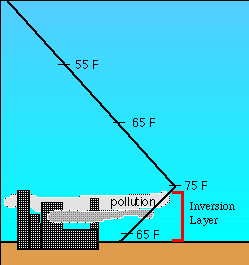Session 1 Focus:
Introduction to Air Quality
At the end of each session, we will include a section that will
focus on
air quality. We will try to relate the importances of topics
covered in
the session to air quality research and/or concerns. Since this
first
session is just an introduction, we will offer an introduction to
air
quality.
In the atmospheric sciences, there are basically two main
categories of
study: rain and no-rain. The "rain" people study storms,
hurricanes,
blizzards, i.e. all the weather in the troposphere. The "no-rain"
people
study subjects such as ionization in the upper atmosphere,
atmospheric
chemistry, or the non-precipitation aspects of meteorology. Air
quality is
a major field in the "no-rain" area. For your information, we
also offer
a web-based atmospheric
chemistry
course.
Air quality deals with everything associated with the quality of
the air
in our atmosphere. Points of interest include the destruction of
stratospheric ozone, the increase and effects of pollutants in
all levels
of the atmosphere, and the long term changes in pollutant
concentrations.
The field of air quality study is huge. In the United States there are thousands of
researchers working on air quality projects at any given time. Air quality research employs scientists from a broad range of disciplines
including physicists, chemists, mathematicians, agricultural
experts, as well as meteorologists.
Since changes in the quality of our air may not cause noticeable
effects
for decades, air quality researchers must focus on possible long
term
effects of small changes in, say, ozone concentrations. A major
problem is
that since there is so few data about the upper atmosphere and
how all of
the pollutants react there, it is difficult to hypothesize how
all these
pollutants really interact, what effects they cause, and whether
or not
the effects are truly detrimental. This is a problem many
researchers
compare to fishing in an ocean with only a dozen fish.
 One of the major recent focuses in the air quality community is
the
Environmental Protection Agency's recent
list of cities in the
nation that have unacceptable amounts of pollution. These cities
have been
listed as non-attainment areas -- they have not attained an
acceptable
quality of air based on EPA's National Ambient Air Quality
Standards (NAAQS). You can view EPA's recent non-attainment
list as well as a table of the National Ambient Air
Quality Standards (NAAQS) on-line from EPA. Atmospheric and
air quality modelers have been working steadily for several years
to try and determine how pollutant concentrations will
change in these non-attainment areas in the future,from the next
day to
the next few decades. Again, the difficulty is creating models
that can
accurately predict those changes.
One of the major recent focuses in the air quality community is
the
Environmental Protection Agency's recent
list of cities in the
nation that have unacceptable amounts of pollution. These cities
have been
listed as non-attainment areas -- they have not attained an
acceptable
quality of air based on EPA's National Ambient Air Quality
Standards (NAAQS). You can view EPA's recent non-attainment
list as well as a table of the National Ambient Air
Quality Standards (NAAQS) on-line from EPA. Atmospheric and
air quality modelers have been working steadily for several years
to try and determine how pollutant concentrations will
change in these non-attainment areas in the future,from the next
day to
the next few decades. Again, the difficulty is creating models
that can
accurately predict those changes.
These are the basics of air quality. Meteorology is an important
background for any effective air quality expert since the change
of the
weather and the dynamics of the atmosphere greatly affect the
movement of
pollution. In session 1, for example we discuss temperature
inversions. These
inversions often occur early in the morning and trap pollutants
near the
surface. That is why the sky often looks hazy in the early
morning in
urban areas. Such examples will be given as applications of
meteorology to
the air quality field throughout this course.




 One of the major recent focuses in the air quality community is
the
Environmental Protection Agency's recent
list of cities in the
nation that have unacceptable amounts of pollution. These cities
have been
listed as non-attainment areas -- they have not attained an
acceptable
quality of air based on EPA's National Ambient Air Quality
Standards (NAAQS). You can view EPA's recent non-attainment
list as well as a table of the National Ambient Air
Quality Standards (NAAQS) on-line from EPA. Atmospheric and
air quality modelers have been working steadily for several years
to try and determine how pollutant concentrations will
change in these non-attainment areas in the future,from the next
day to
the next few decades. Again, the difficulty is creating models
that can
accurately predict those changes.
One of the major recent focuses in the air quality community is
the
Environmental Protection Agency's recent
list of cities in the
nation that have unacceptable amounts of pollution. These cities
have been
listed as non-attainment areas -- they have not attained an
acceptable
quality of air based on EPA's National Ambient Air Quality
Standards (NAAQS). You can view EPA's recent non-attainment
list as well as a table of the National Ambient Air
Quality Standards (NAAQS) on-line from EPA. Atmospheric and
air quality modelers have been working steadily for several years
to try and determine how pollutant concentrations will
change in these non-attainment areas in the future,from the next
day to
the next few decades. Again, the difficulty is creating models
that can
accurately predict those changes.
 The
Shodor
Education Foundation, Inc.
The
Shodor
Education Foundation, Inc.